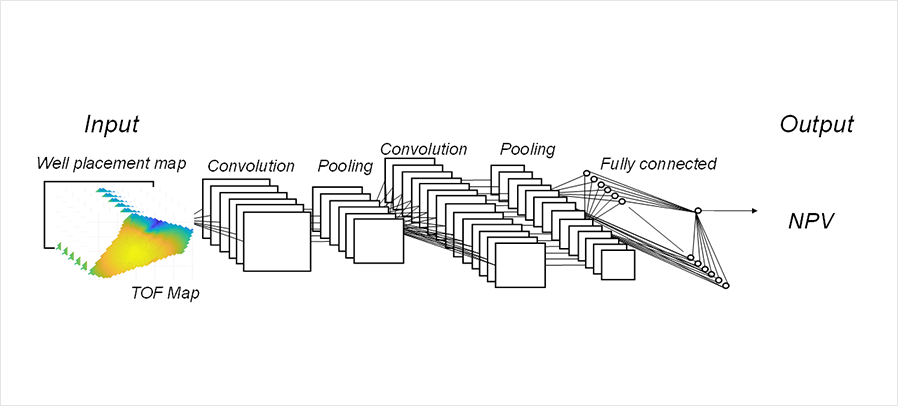
Development of a deep learning model for the prediction of the optimality of brine extraction well locations
Rapid optimization of brine extraction well placement for mitigation of reservoir pressure buildups
Professor Hoonyoung Jeong has been researched safe and efficient geological carbon storage (GCS) in the Department of Energy Resources Engineering. Prof. Jeong mainly shows interest in geological modeling, numerical simulation of subsurface fluid flow, and optimization of CO2 injection for safe and efficient GCS.
Geological carbon storage is one of the key technologies for reducing carbon emissions. In GCS projects, it is critical to store injected CO2 safely in target rock formations for hundreds of years. However, CO2 injection into subsurface rock formations causes reservoir pressure buildup. The excessive reservoir pressure buildup may lead to serious safety issues such as induced seismicity, caprock damage, fault slip, and leakage of formation brine and injected CO2. To successfully achieve long-term carbon storage, reservoir pressure management remains one of the most important factors. Extracting pre-existing formation brine from a brine extraction well may mitigate reservoir pressure buildup. The placement of a brine extraction well significantly affects the performance of brine extraction in heterogeneous reservoirs; too close or too far placement of the brine extraction well, respectively, results in early CO2 breakthrough and insignificant pressure mitigation. The location of the brine extraction well should be determined carefully since the offshore drilling cost is likely to be tens of millions of dollars. Nevertheless, optimizing a brine extraction well location is computationally costly, as it requires many reservoir simulations run.
Prof. Jeong has developed an efficient deep-learning-based surrogate model that quickly finds the optimal location of a brine extraction well. Figure 1 shows the deep model structure of the proposed method. The input data of the deep learning model structure are a brine well location and a time of flight (TOF) map for the brine well locations, which represents the hydraulic connectivity from the brine extraction well location. The hydraulic connectivity from the brine extraction well location affects the optimality of a brine extraction well location, thus requiring the TOF map data. The net present value (NPV), which is calculated using the tax credit for CO2 injection and the cost for brine extraction, becomes the output data of the learning model structure. The deep learning model structure consists of convolution neural layers, pooling layers, and a fully connected neural network.

Figure 1 Deep learning model structure of the proposed method
The CO2 storage site in the Pohang basin located in the East sea of Korea, shown in Figure 2, utilizes this proposed method. By using a reservoir simulator, researchers obtained a training data set, which is a set of brine extraction well locations and corresponding NPVs. The coefficient of determination between actual and predicted NPVs was 0.87 for the test data. Researchers achieved this high prediction performance of the proposed method by training the deep learning model using only 10% of the whole location candidates.

Figure 2 Pohang basin model
This method may assist in finding the optimal location of a brine extraction well rapidly and efficiently for mitigating reservoir pressure buildups which incur safety issues in geological carbon storage. Prof. Jeong is currently working on robust optimization for multiple geological models using the proposed method. He expects the developed method to save the computational cost of the robust optimization significantly. Prof. Jeong is also working on the optimization of CO2 injection and transport plans for safe and efficient CO2 storage and transport.
References
- Yun, H. and Jeong, H., 2021, Deep-learning-based surrogate model for brine extraction well placement for geological carbon storage, 13th Annual Meeting, InterPore2021.
- Jeong, H., Sun, A.Y., Jeon, J., Min, B., Jeong, D., 2020. Efficient Ensemble-Based Stochastic Gradient Methods for Optimization Under Geological Uncertainty. Front. Earth Sci. 8, 108.
https://doi.org/10.3389/feart.2020.00108
- Jeong, H., Sun, A.Y., Zhang, X., 2018. Cost-optimal design of pressure-based monitoring networks for carbon sequestration projects, with consideration of geological uncertainty. Int. J. Greenh. Gas Control 71, 278–292.
https://doi.org/10.1016/j.ijggc.2018.02.014
- Ren, B., Jeong, H., 2018. Influence of injection strategies on local capillary trapping during geological carbon sequestration in saline aquifers. J. CO2 Util. 27, 441–449.
https://doi.org/10.1016/J.JCOU.2018.08.021
- Jeong, H., Srinivasan, S., 2016. Fast assessment of CO2 plume characteristics using a connectivity based proxy. Int. J. Greenh. Gas Control 49, 387–412.
https://doi.org/10.1016/j.ijggc.2016.03.001
- Jeong, H., Srinivasan, S., Bryant, S., 2013. Uncertainty Quantification of CO2 Plume Migration Using Static Connectivity of Geologic Features. Energy Procedia 37, 3771–3779.
https:https://doi.org/10.1016/j.egypro.2013.06.273
- Yun, H. and Jeong, H., 2021, Deep-learning-based surrogate model for brine extraction well placement for geological carbon storage, 13th Annual Meeting, InterPore2021.
- Jeong, H., Sun, A.Y., Jeon, J., Min, B., Jeong, D., 2020. Efficient Ensemble-Based Stochastic Gradient Methods for Optimization Under Geological Uncertainty. Front. Earth Sci. 8, 108.
https://doi.org/10.3389/feart.2020.00108
- Jeong, H., Sun, A.Y., Zhang, X., 2018. Cost-optimal design of pressure-based monitoring networks for carbon sequestration projects, with consideration of geological uncertainty. Int. J. Greenh. Gas Control 71, 278–292.
https://doi.org/10.1016/j.ijggc.2018.02.014
- Ren, B., Jeong, H., 2018. Influence of injection strategies on local capillary trapping during geological carbon sequestration in saline aquifers. J. CO2 Util. 27, 441–449.
https://doi.org/10.1016/J.JCOU.2018.08.021
- Jeong, H., Srinivasan, S., 2016. Fast assessment of CO2 plume characteristics using a connectivity based proxy. Int. J. Greenh. Gas Control 49, 387–412.
https://doi.org/10.1016/j.ijggc.2016.03.001
- Jeong, H., Srinivasan, S., Bryant, S., 2013. Uncertainty Quantification of CO2 Plume Migration Using Static Connectivity of Geologic Features. Energy Procedia 37, 3771–3779.
https:https://doi.org/10.1016/j.egypro.2013.06.273


